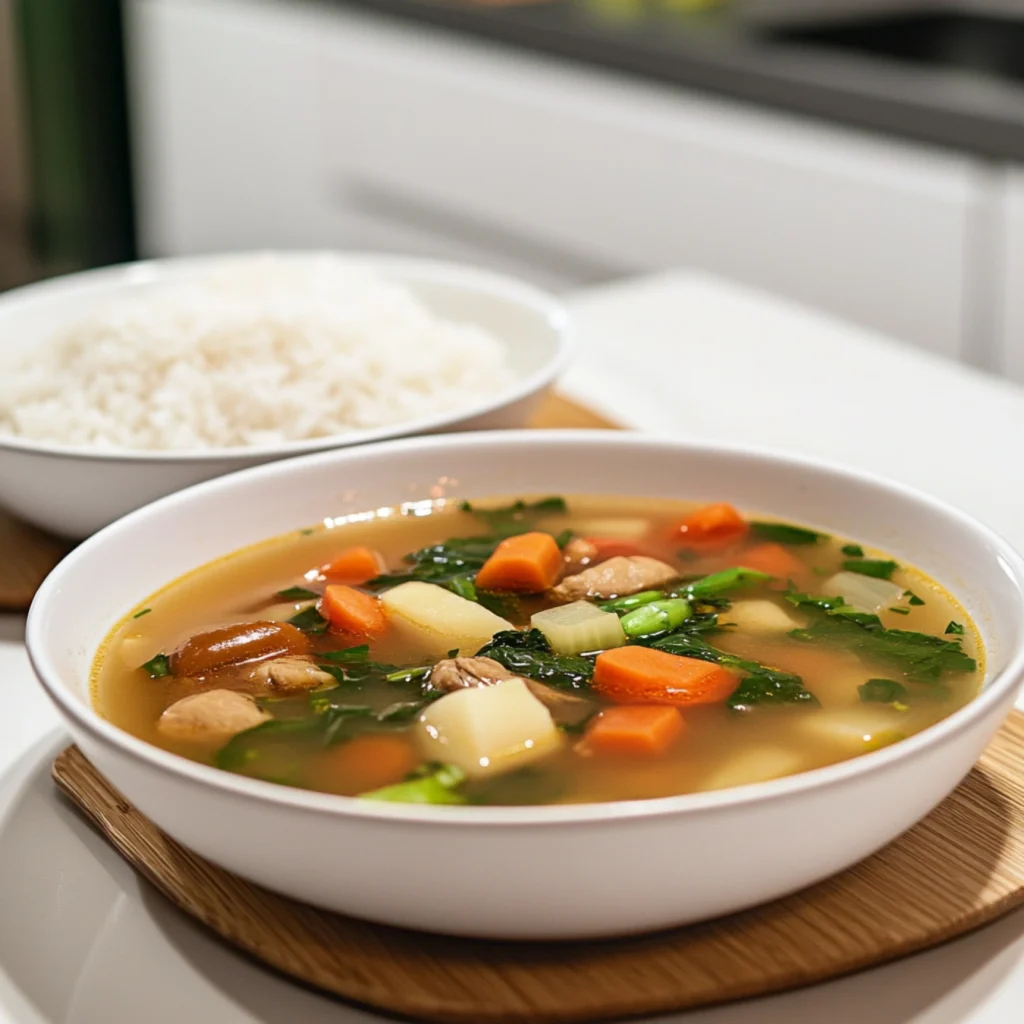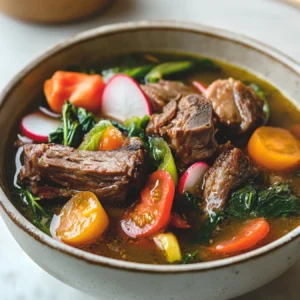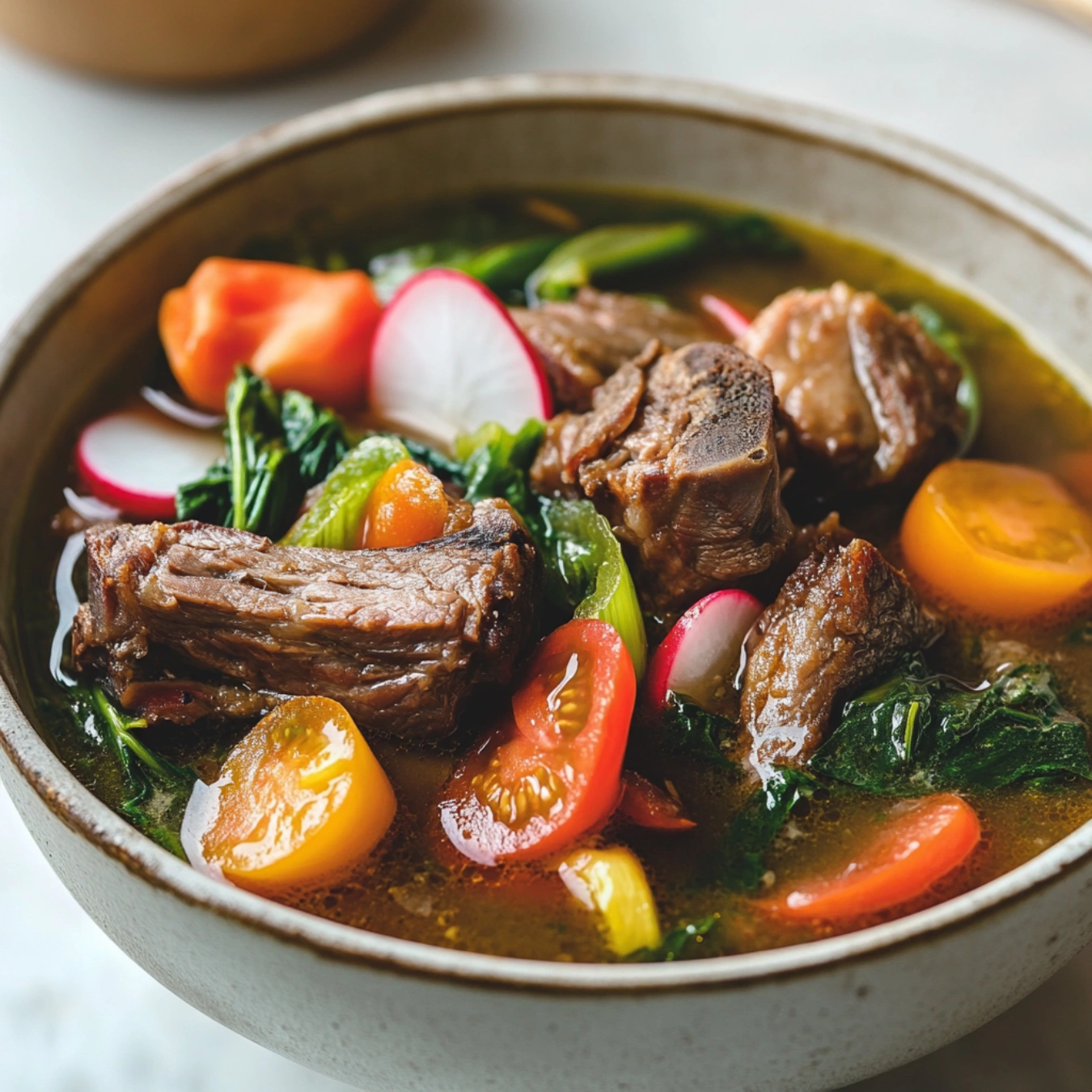Sinigang Recipe is the one meal that epitribes Filipino comfort cuisine. Tender Beef, fresh veggies, and that distinctive mouth-puckering broth that makes every mouthful delicious abound in this tangy, savory, somewhat spicy tamarind-based soup.
Whether it’s a Sunday family lunch, a rainy day, or just one of those times when you yearn for something substantial and cozy, sinigang is the kind of meal that warms the soul. The umami-rich broth, succulent Beef, and crisp-tender vegetables wonderfully offset the tamarind’s sourness naturally, it’s best eaten with a large dish of steaming rice.
Make a pot of delicious real Filipino Sinigang and bring a little of the Philippines into your kitchen!
Table of Contents
Why You’ll Love This Recipe
✔ Real Flavor: The ideal mix of sour, savory, and a little bit of spice.
✔ Flexible & Customizable: use Beef, beef, prawns, or fish!
✔ Loaded with Fresh Vegetables : A strong combination of greens, radish, aubergine, and more; Easy to Make : Just basic ingredients cooked to perfection without difficult techniques.
✔ Perfect for Meal Prep; the tastes improve even the next day!
Want to try other comforting soups? Check out this Chicken Bone Broth Soup Recipe for another nourishing, slow-cooked broth.
Components
Here is all you need for a traditional, consoling Sinigang:
- Tender, luscious soup bases are perfect for long-simmering Beef belly or Beef ribs, these.
- Water – The broth’s foundation.
- Tomatoes and onions give the soup natural depth and flavor.
- The secret element for that trademark sour taste is tamarind soup base (sinigang mix!).
- Fish sauce accentuates a salty umami punch.
- For harmony and flavor, salt and black pepper.
- Daikon radish, for the vegetables, is mild, somewhat sweet, and absorbs all the great flavors.
- Long green beans accentuate texture and sharpness.
- Eggplant absorbs the broth brilliantly.
- Okra – For a slightly silky texture.
- Add a fresh, green accent with water spinach (kangkong) or Bok Choy.
- Optional green chili peppers provide a slight heat sensation.
👉 The complete ingredient list with measurements is in the recipe card below!
Looking for a beef-based Filipino dish? Try Beef Pares for a sweet and savory alternative.
How to Create Original Sinigang?
First, get the Beef ready.
- Bring six cups of water to a boil in a big pot at medium-high heat.
- Add the Beef chunks; cook for five minutes. To eliminate contaminants, drain and clean the meat; this keeps the soup clear!
- Six cups of fresh water will help you to refill the pot. Could you bring it back to boil?
Second: Cook the base slowly.
- Toss the onion, tomatoes, and meat in boiling water. Cover and boil until the meat is delicious and tender—30 minutes.
Step 3: Add the Seasonings & Tamarind Flavor
- Add to the tamarind soup base fish sauce, salt, and black pepper. To spread the taste, mix well.
Step 4: Stage Vegetable Addition
- Add eggplant, green beans, and daikon radish. To meld the flavors, let simmer for five minutes.
- If using, cook for another three minutes after stirring in the okra and green chili peppers.
Step 5: Finish with Leafy Greens.
- Add the bok choy or water spinach, swirling gently. Cook for one minute; then turn off the heat.
Step 6: Correct and Present.
- Taste the soup and change the seasonings; add more tamarind mix or fish sauce if necessary.
- Present hot beside steaming rice and flavorful, tangy, warming spoonfuls will be much appreciated!

Pro Tips for the Best Sinigang
✔ Use Bone-In Beef – Ribs or Beef belly with bone gives more depth and richness to the broth. Simmer Low & Slow : This assures tender meat and fully developed tastes. Fresh Tamarind? Even Better! If you have fresh tamarind pods, boil them until soft, mash, and filter into the broth for a naturally occurring tart punch.
✔ Add the Greens Last: A quick dunk in the broth is all they require; overcooked leafy greens go mushy!
✔ Make It Spicier: Cut chili peppers or sprinkle a little sriracha if you want it hot.
Serving and Pairing Sinigang: Tips
Best eaten hot, sinigang goes well with:
- A must-have for absorbing the sour-savory broth is steamed white rice.
- Perfect crispy contrast to the sour soup, grilled or fried Beef belly
- A Side of Chili and Fish Sauce to Boost Umami
- Extra Extra Green Chilies: If every mouthful tastes like more heat.
Bonus: The next day, leftovers sinigang. As it sits, the broth gets even more delicious!
Make Ahead and Organization and Storage
Maintaining Leftovers
Keep refrigerated in an airtight container for up to three days.
Cooking Again
If the broth has thickened, gently reheat on the hob over medium heat, adding a splash of water.
Freezing
True! Store the broth, sans the greens, in a sealed jar for up to two months frozen.

Frequencies of Questions
I could use another protein instead.
True! Sinigang can be produced using:
✔ Beef (Sinigang Na Baka) : Rich, deeper broth.
✔ Shrimp (Sinigang Na Hipon) : Seafood-forward, light, fresh.
✔ Fish (Sinigang Na Isda) Taste fantastic with milkfish or tilapia.
What if I don’t have a Sinigang mix?
Substitute fresh tamarind paste, calamansi juice, or even lemon juice for the sourness.
Could I create a vegetarian?
Indeed. Change the Beef with tofu and substitute veggie broth.
Why isn’t my sinigang sufficiently sour?
Add fresh tamarind juice or extra tamarind mix to get that distinctive taste.
Conclusion
A perfect bowl of warmth and memories, this authentic Filipino sinigang is sour, flavorful, and loaded with comforting tastes. This recipe will always be perfect whether you’re cooking for a family get-together, a rainy day, or just because you enjoy Filipino cuisine.
One taste of that rich, tamarind-infused soup will help you to appreciate why Sinigang is a Filipino favourite. 😊 🍲

Classic Filipino Sinigang Recipe
Ingredients
For the Broth:
- 1 ½ lbs Beef belly or Beef ribs, shrimp, or beef shank
- 6 cups water
- 1 medium onion quartered
- 2 medium tomatoes quartered
- 1 40g pack sinigang mix (or 1/2 cup fresh tamarind paste)
- 1 tbsp fish sauce patis
- 1 tsp salt
- ½ tsp black pepper
- For the Vegetables:
- 1 cup string beans sitaw, cut into 2-inch pieces
- 1 medium radish labanos, sliced thinly
- 1 medium eggplant sliced
- 2 medium okra whole
- 1 small green chili siling haba (optional for spice)
- 2 cups water spinach kangkong or bok choy
Instructions
Step 1: Boil the Beef
- In a large pot, add Beef, water, onion, and tomatoes.
- Bring to a boil, then simmer for 30 minutes until the meat is tender.
Step 2: Flavor the Broth
- Add sinigang mix (or tamarind paste), fish sauce, salt, and black pepper.
- Stir and let simmer for 5 minutes.
Step 3: Add the Vegetables
- Add radish, eggplant, and okra, and cook for 5 minutes.
- Stir in string beans and green chili, cooking for 3 minutes.
- Lastly, add kangkong (or bok choy) and let simmer for 1 minute.
Step 4: Serve & Enjoy!
- Taste and adjust seasoning if needed.
- Serve hot with steamed rice and fish sauce for dipping.
Notes
Prefer a milder broth? Use less sinigang mix or tamarind paste.
Store leftovers in the fridge for up to 3 days.

